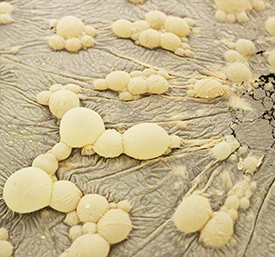The Unvarnished Truth About Pellicle Infections in Beer and Wine
Posted by Matteo Lahm on 21st Aug 2023
If you're a homebrewer or a winemaker, you've probably heard of the dreaded pellicle infection. It's the stuff of nightmares, right? Well, let's cut through the hype and get down to the nitty-gritty.
A pellicle infection manifests as a thin, often patchy layer on the surface of your fermenting beer or wine. It's a bit like a film or a veil, and it can range in color from white to gray to a sort of murky brown. The texture can vary too - it might be smooth and shiny, or it could be rough and lumpy.
Sometimes, you might see bubbles trapped beneath the surface of the pellicle, giving it a sort of blistered appearance. In other cases, the pellicle might form a more solid, leathery layer that cracks when disturbed.
It's also worth noting that the appearance of the pellicle can change over time. It might start off as a few isolated patches, then gradually spread to cover the entire surface of your brew. Or, it might form a solid layer right off the bat.

In short, a pellicle infection can take on many forms, but it's always a clear sign that wild yeast or bacteria have set up shop in your brew. It's not the most pleasant sight, but it's a part of the brewing process that every brewer should be familiar with. It's not exactly a sight for sore eyes, but it might not be the end of the world either.
So, how does this happen?
Wild yeast and bacteria are all around us. They're in the air we breathe, on the surfaces we touch, and yes, in our brewing spaces. These microscopic organisms are just waiting for the right conditions to multiply and thrive.
When we talk about your brew coming into contact with wild yeast or bacteria, it could happen in several ways. One of the most common is through unsanitized equipment. If your fermenter, airlock, or any other tool you're using isn't properly cleaned and sanitized, it could harbor these unwanted guests and introduce them to your batch.
Another way is through the air. When you open your fermenter to check on your brew, airborne yeast and bacteria can seize the opportunity to swoop in. This is why it's crucial to limit the exposure of your brew to open air. This is more of an issue with beer than wine.
Even the ingredients you use can be a source of wild yeast or bacteria. For instance, if you're brewing a beer with fresh fruit, there's a chance it could carry wild yeast or bacteria on its skin.
In essence, these infections originate from the environment. They're opportunistic, and they'll take advantage of any chance they get to infiltrate your brew. This is why proper sanitation and careful handling are so important in your brewing process. Another potential cause of pellicle infection is pH. They thrive in lower acidity environments.
Now, here's the million-dollar question: is a pellicle infection treatable? The answer is a resounding 'maybe'. If you catch it early, you can try to salvage your batch by racking it off the sediment and into a new, sanitized container. But, if the infection has taken hold, it might be too late. With beer, this is your only option. With wine, you can also treat it with sulfites.The earlier you catch it, the better chance you have. Secondly, enough sulfites can and probably will kill off the infection however, this could impart burnt matches flavors and aromas that are even more off-putting than the flavors of the infection itself.
But wait, there's more. Is your beer or wine still drinkable if it gets infected? Well, it depends on your palate. First off, it's important to note that the flavors imparted by a pellicle infection can vary widely, depending on the specific strain of bacteria or wild yeast involved. However, there are some common characteristics that many brewers and wine makers have reported.

One of the most common flavors associated with a pellicle infection is a sour or tart taste. This is often the result of lactic acid bacteria, which produce lactic acid as a byproduct of fermentation. This can give your brew a tangy, puckering quality, similar to a sourdough bread or a tart yogurt.
Another common flavor is funkiness, often described as earthy, barnyard, or even cheesy. This is typically the work of Brettanomyces, a type of wild yeast that's known for its unique flavor contributions.
Some brewers also report fruity or spicy notes, such as apple, pineapple, clove, or even smoke. These flavors can add complexity and depth to your brew, making it more interesting and layered.
However, it's important to note that while some people find these flavors intriguing and enjoyable, others might find them off-putting. It's a matter of personal preference. If you're a fan of sour beers or natural wines, you might appreciate the unique character that a pellicle infection can bring. Furthermore, if you are back sweetening, those sour flavors can be counter balanced for interesting results. But if you prefer your brews clean and straightforward, a pellicle infection might not be your cup of tea.
And finally, will you have to dump the batch? Not necessarily. If the taste is too funky for your liking, you might choose to toss it. But if you're feeling adventurous, you could let it ride and see what happens.
In conclusion, a pellicle infection isn't the end of the world. It's a bump in the road, sure, but it's not a death sentence for your brew. So, keep your equipment clean, keep an eye on your brew, and don't be afraid to roll with the punches. After all, brewing is as much about the journey as it is about the destination. Cheers!

